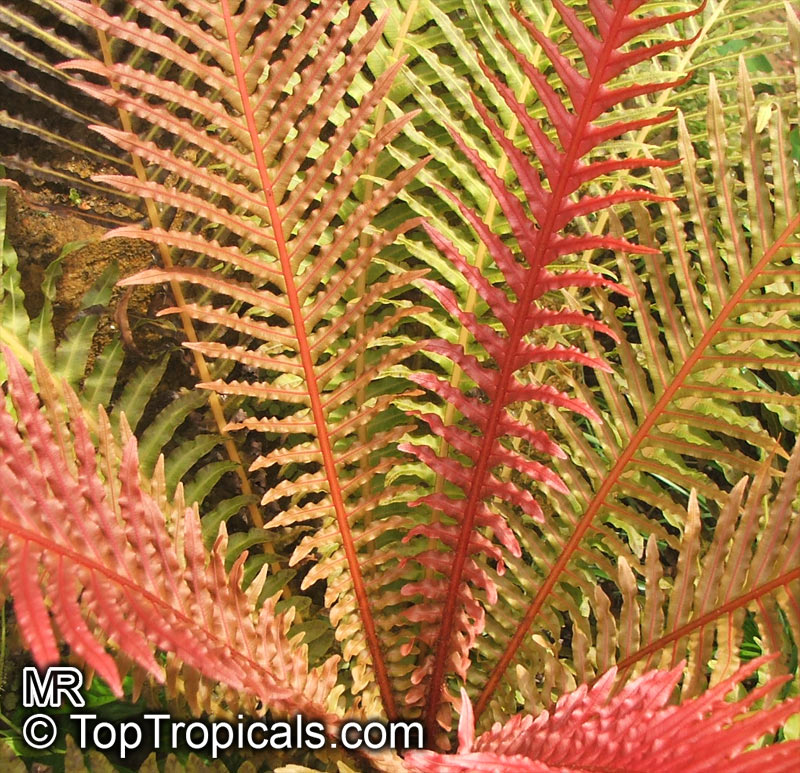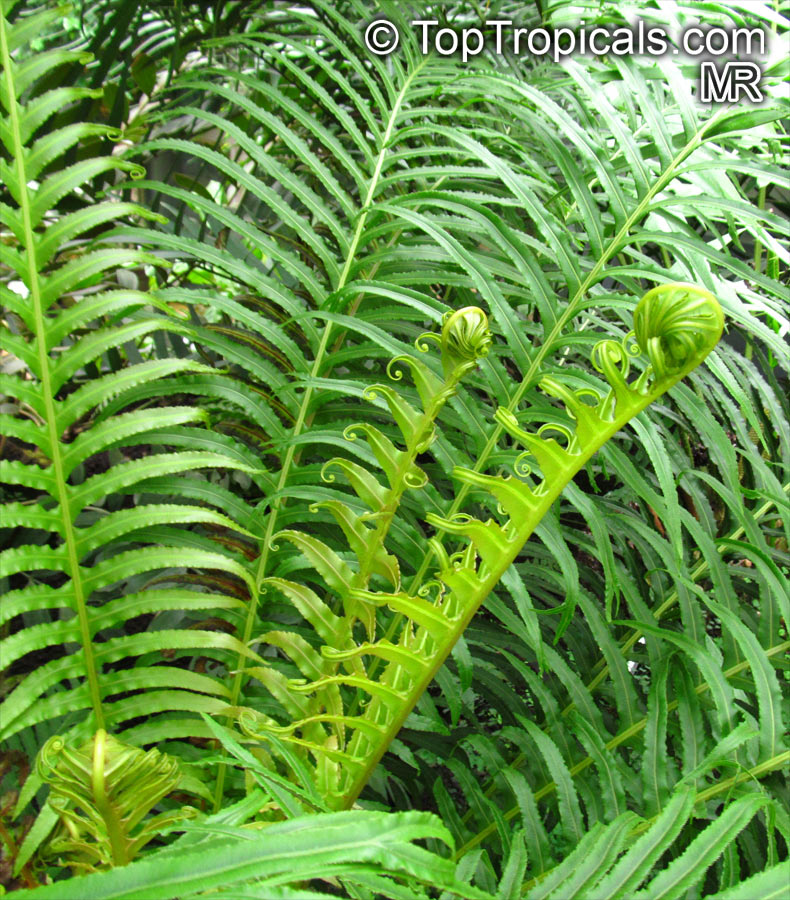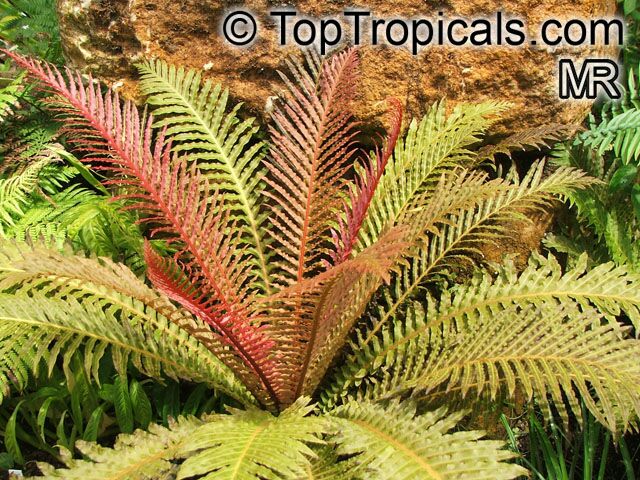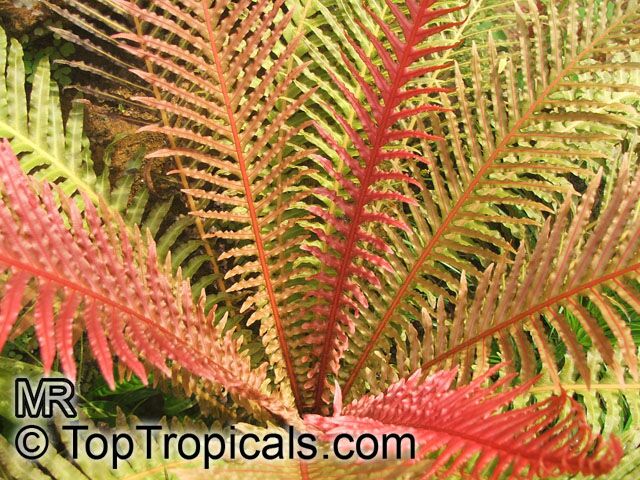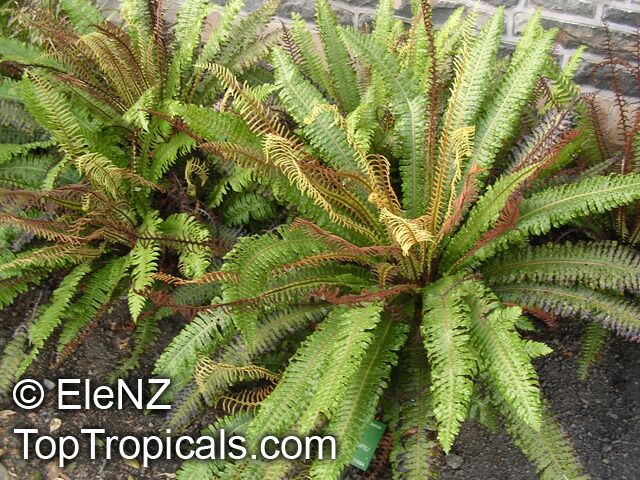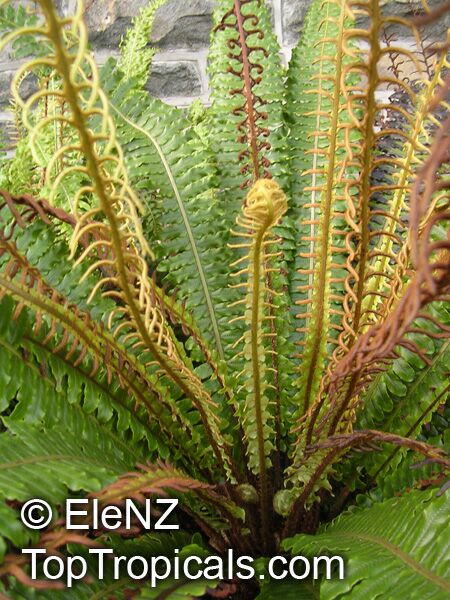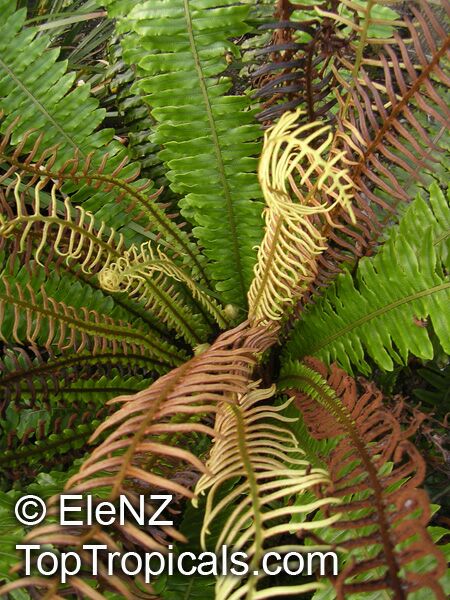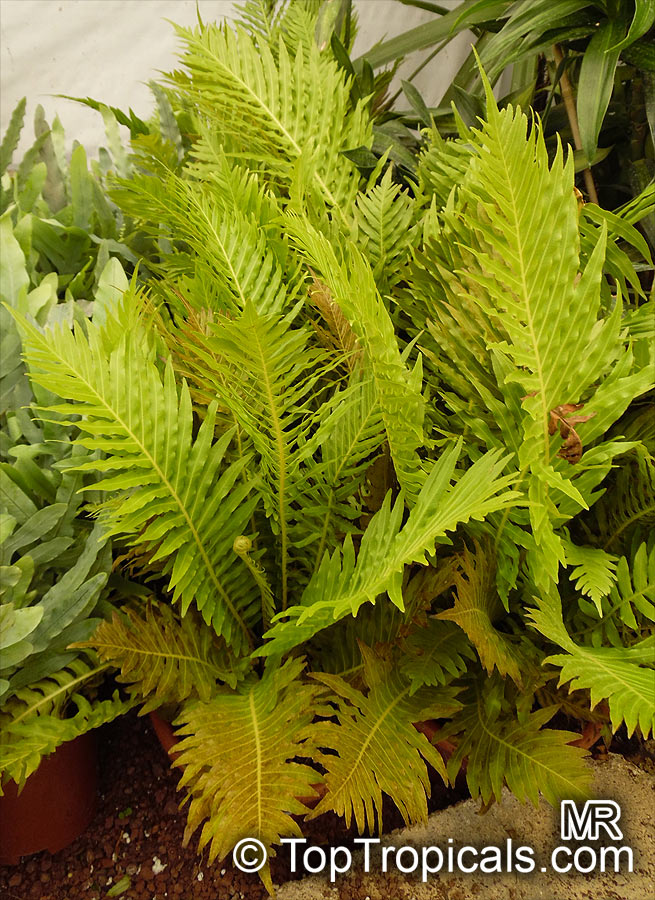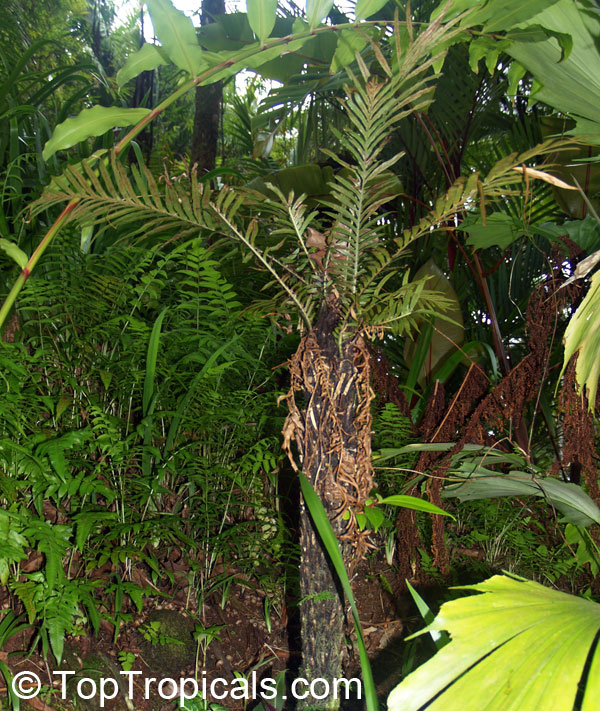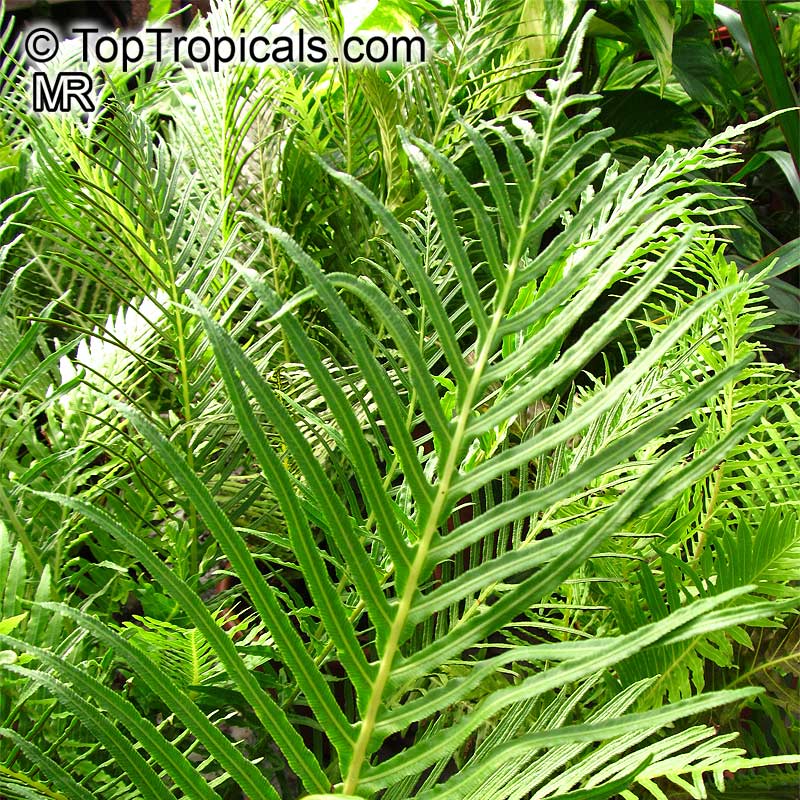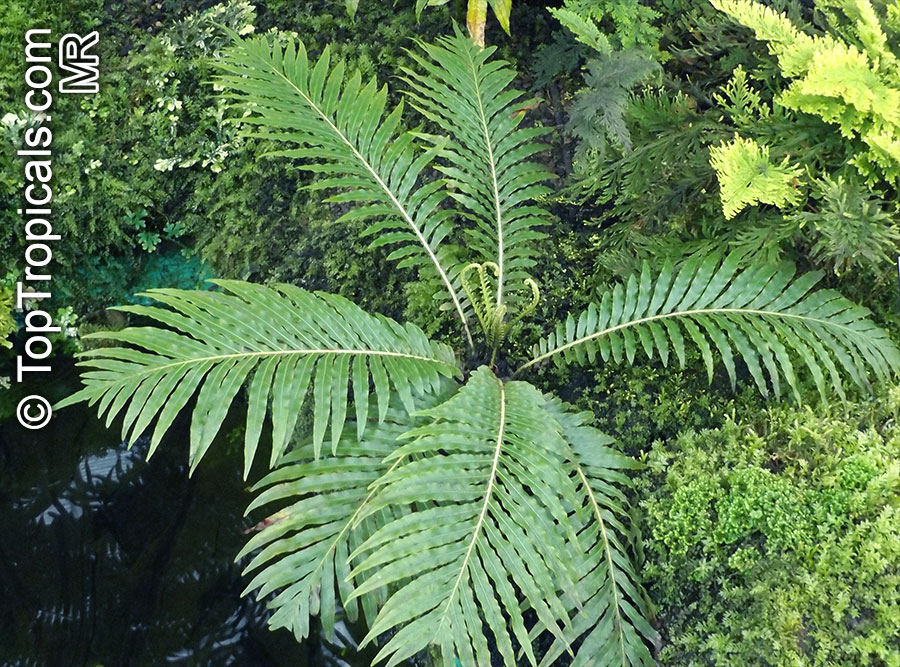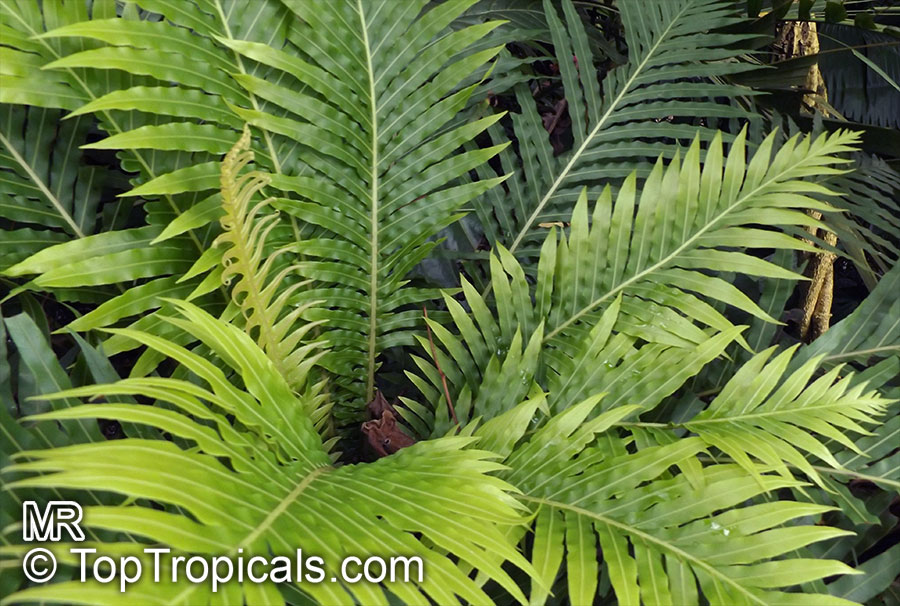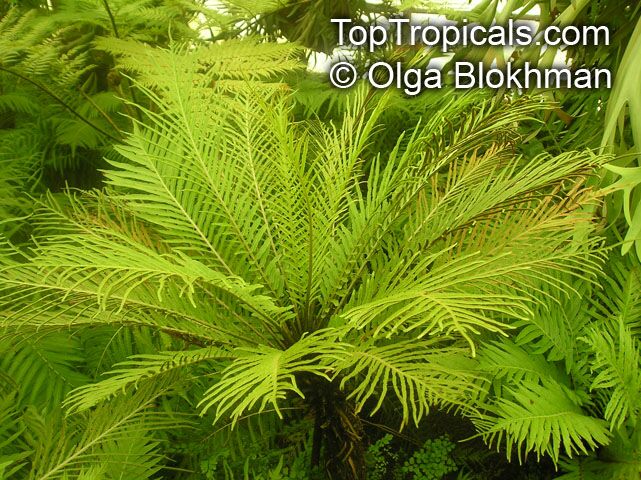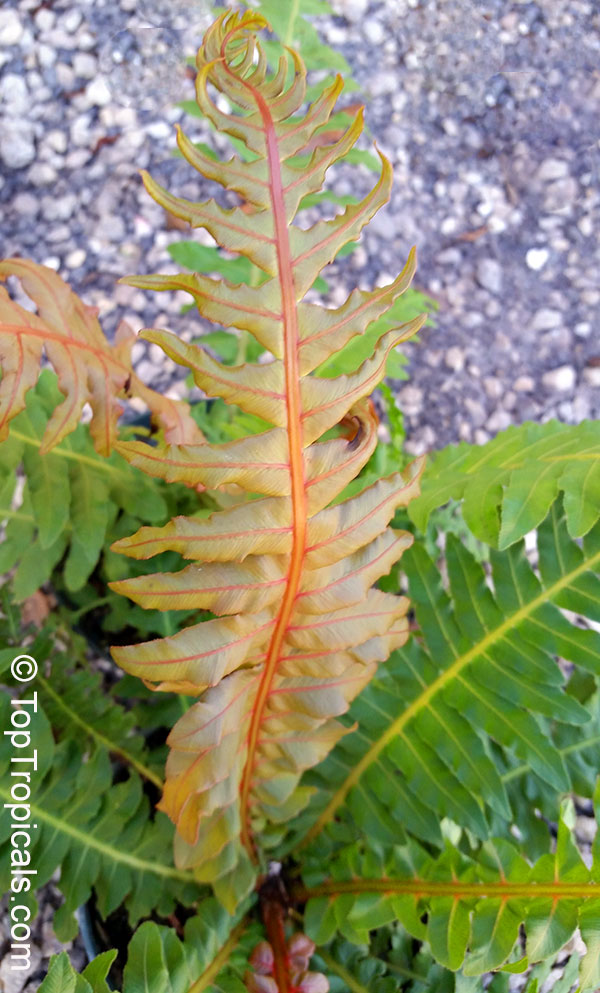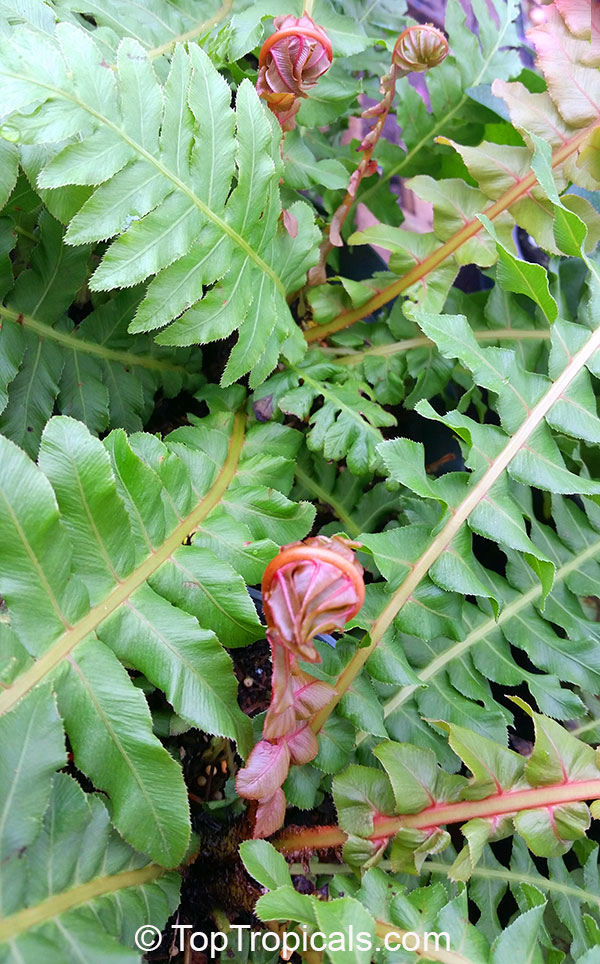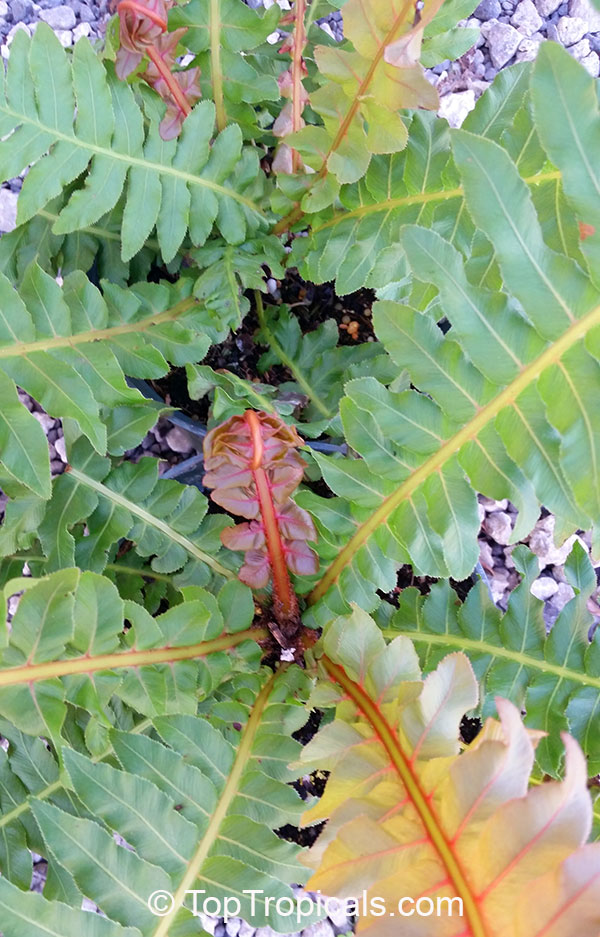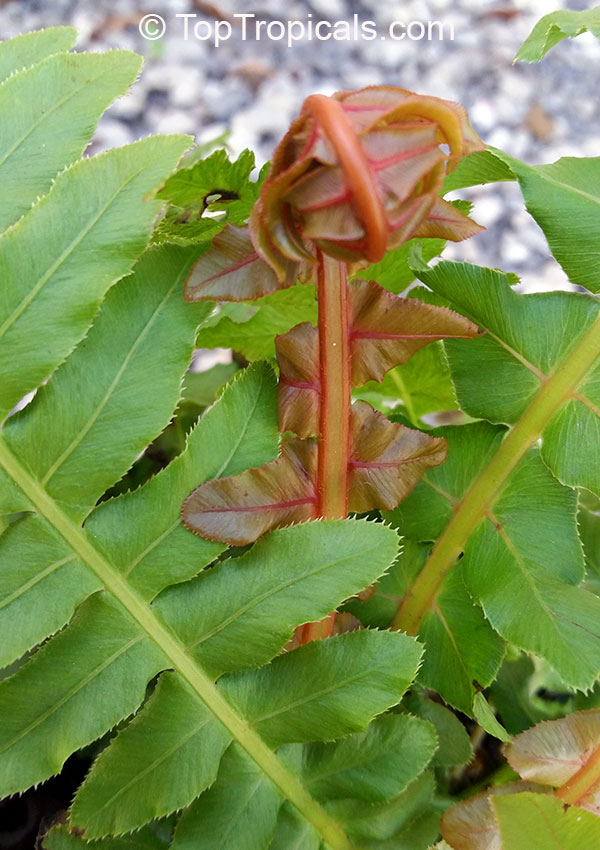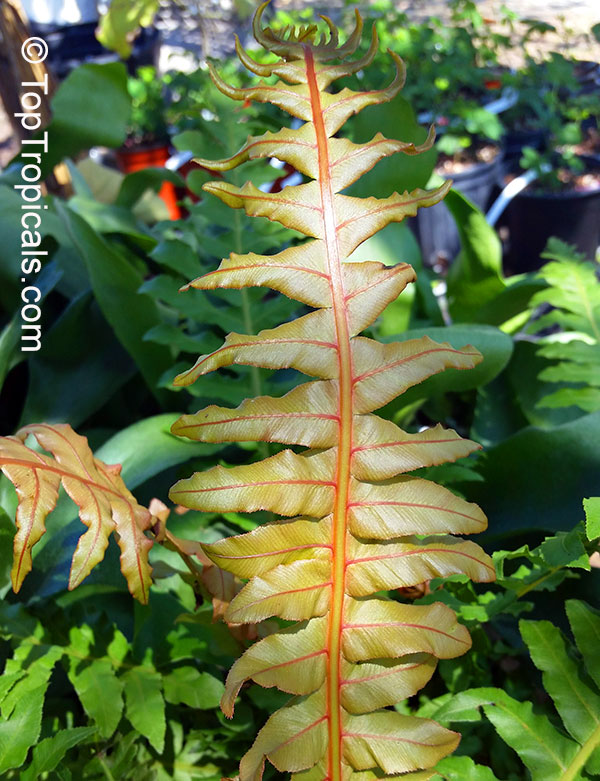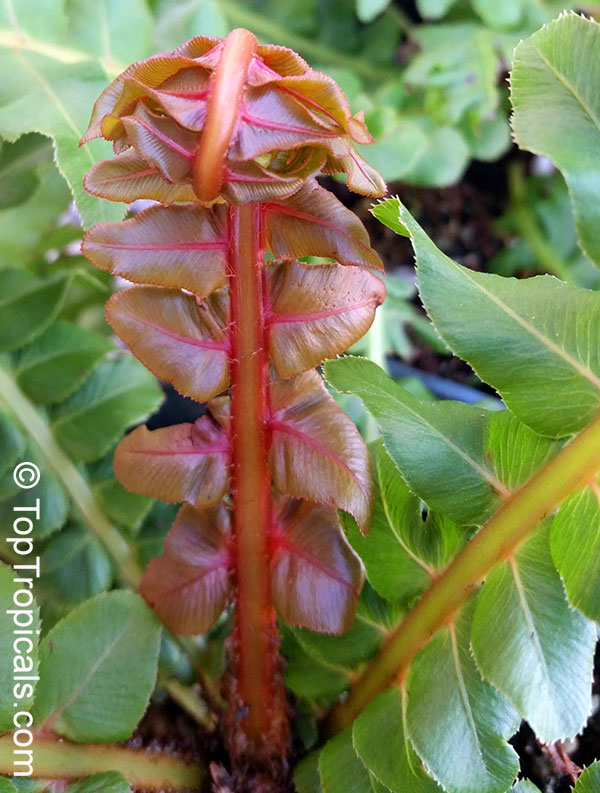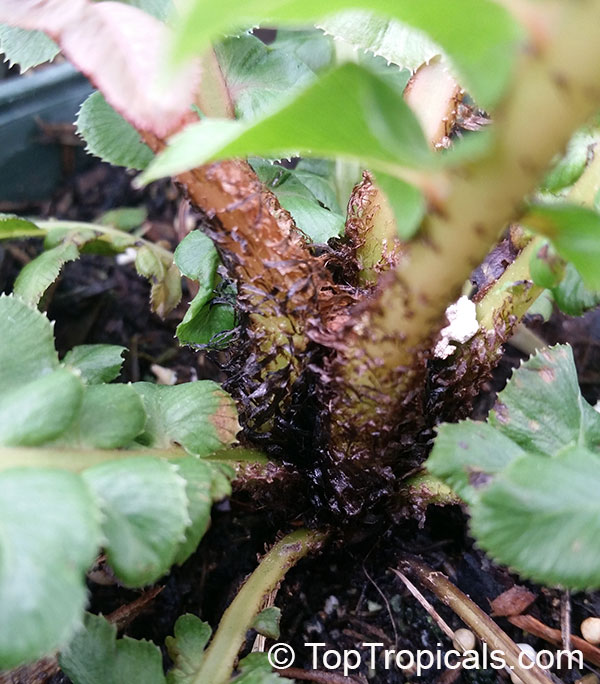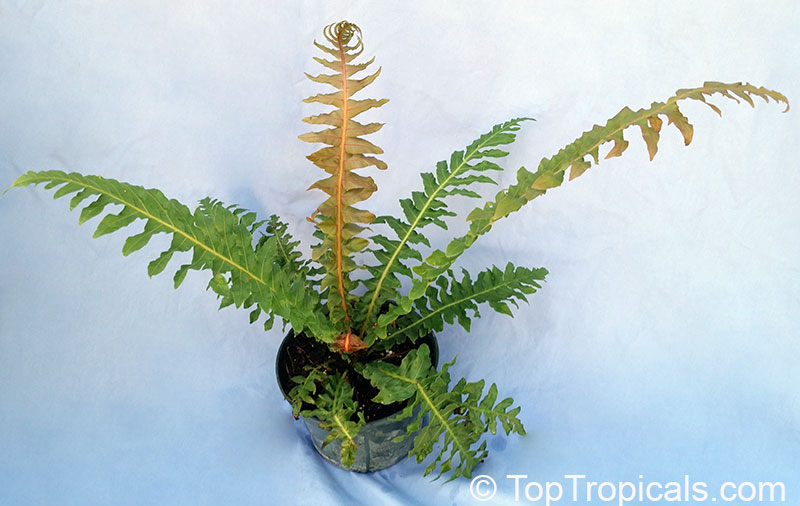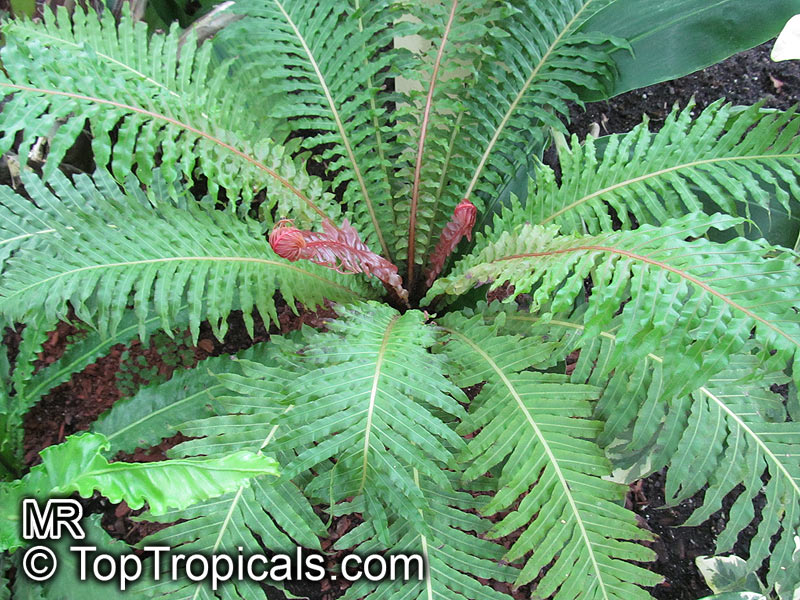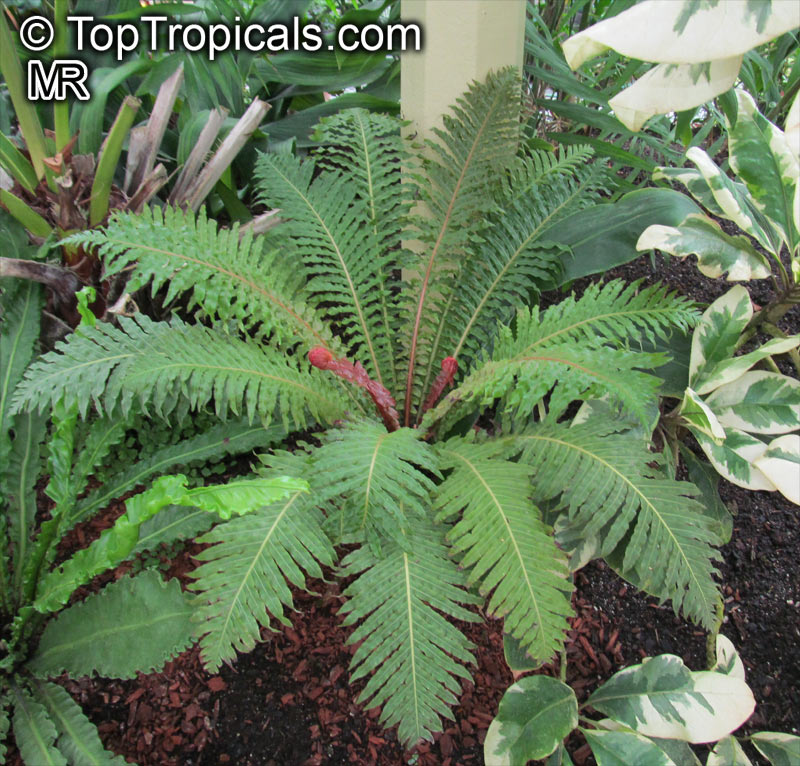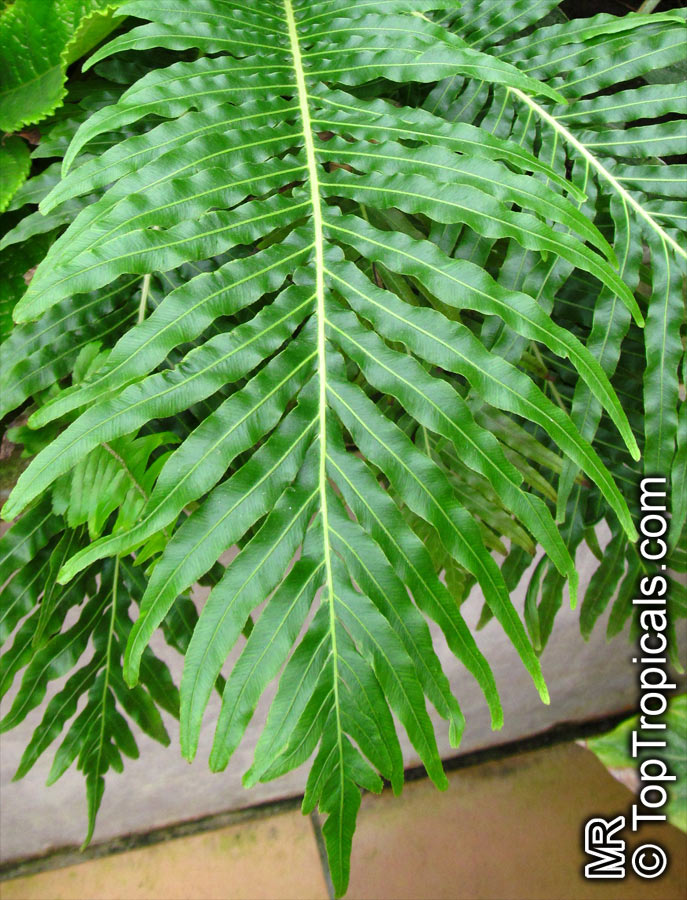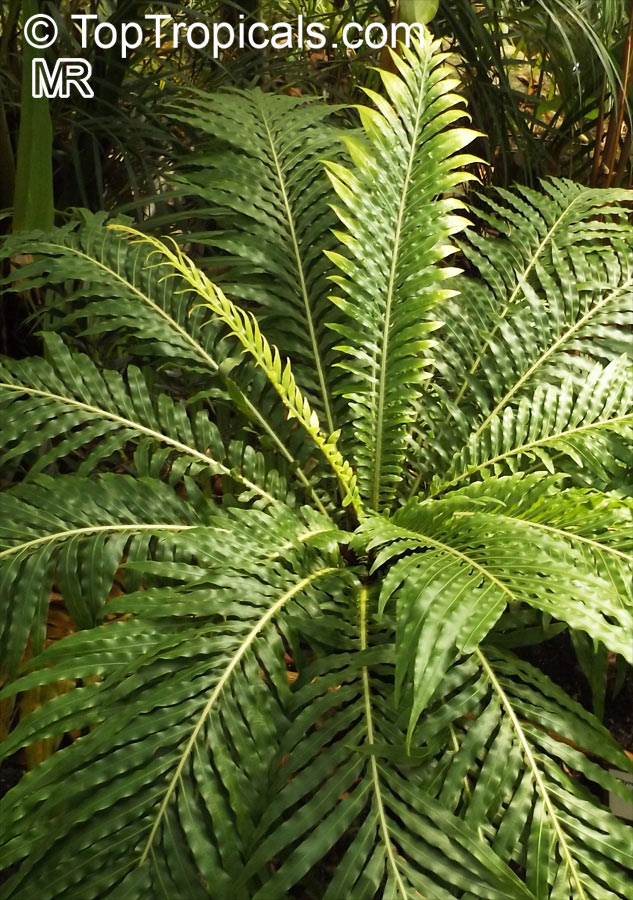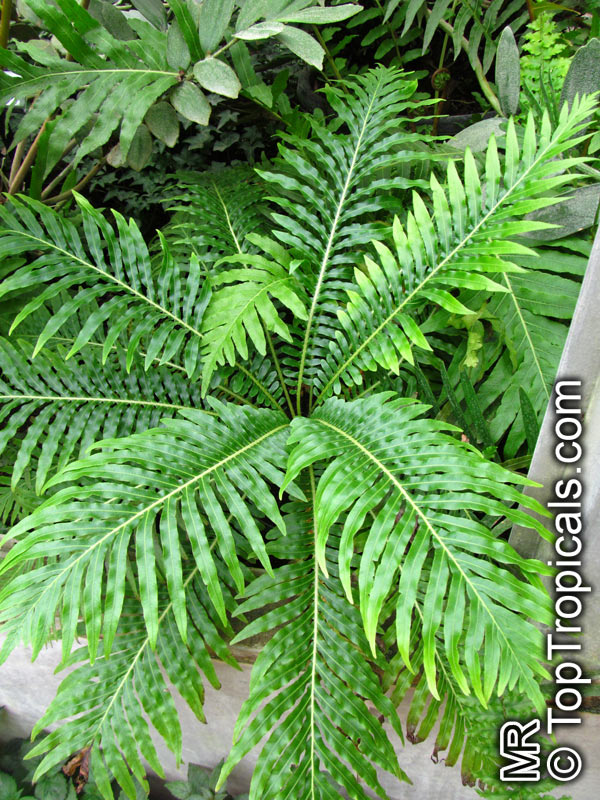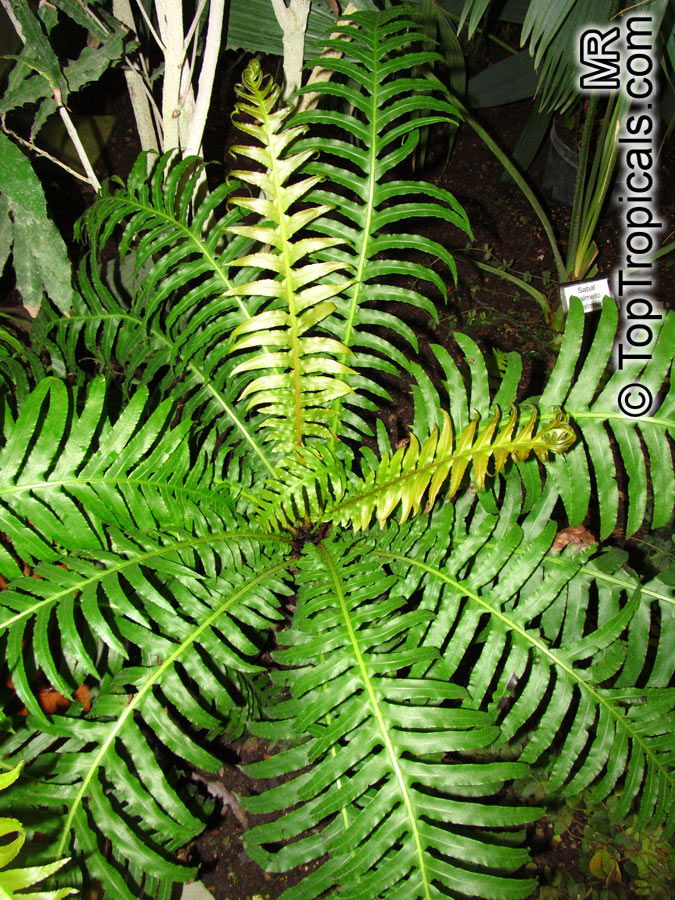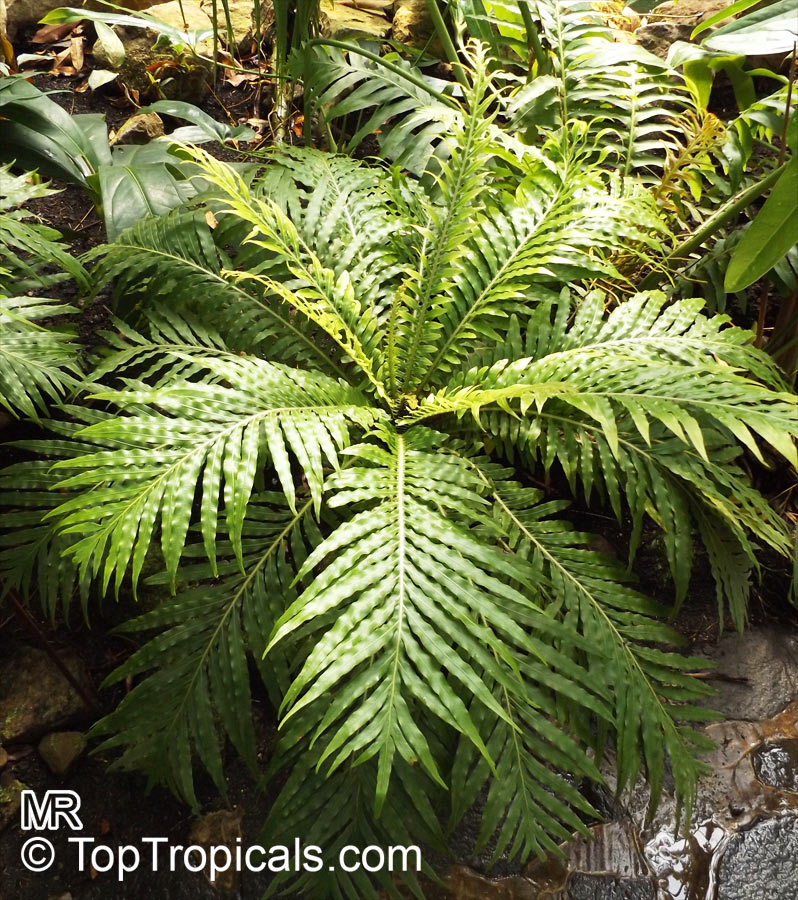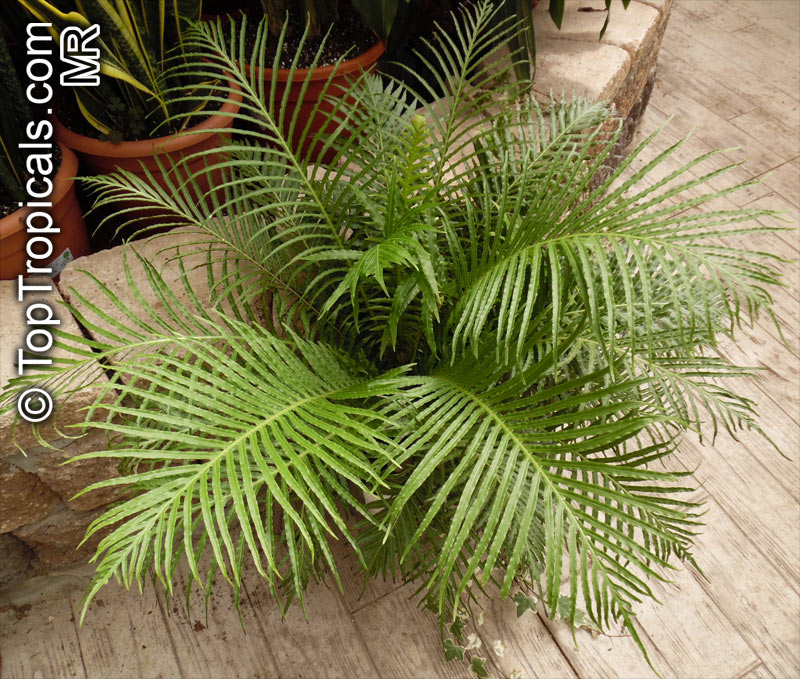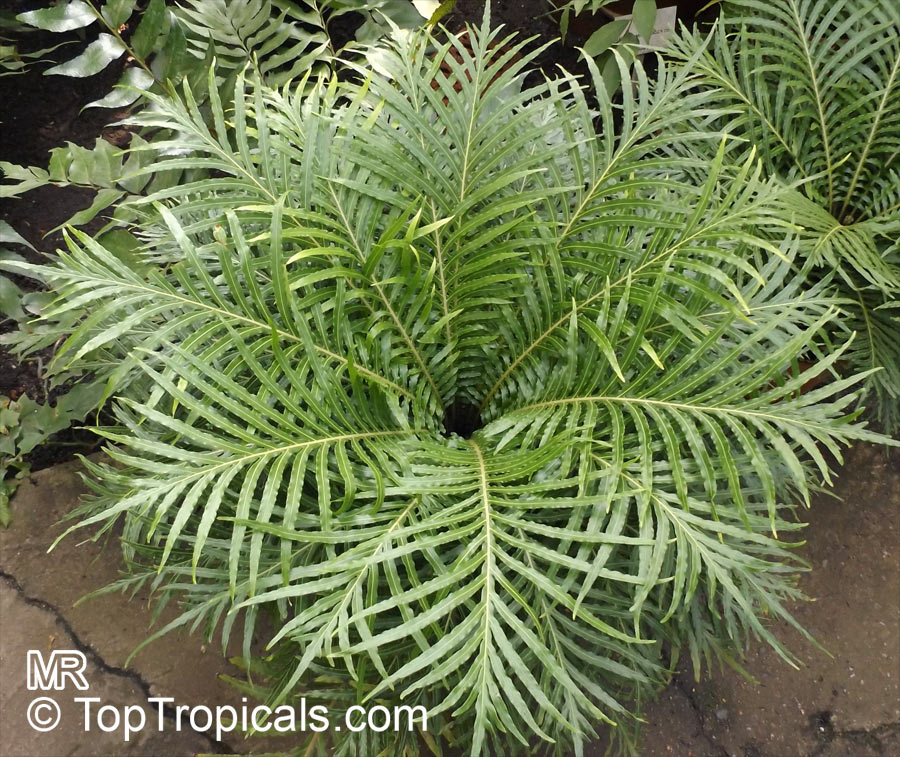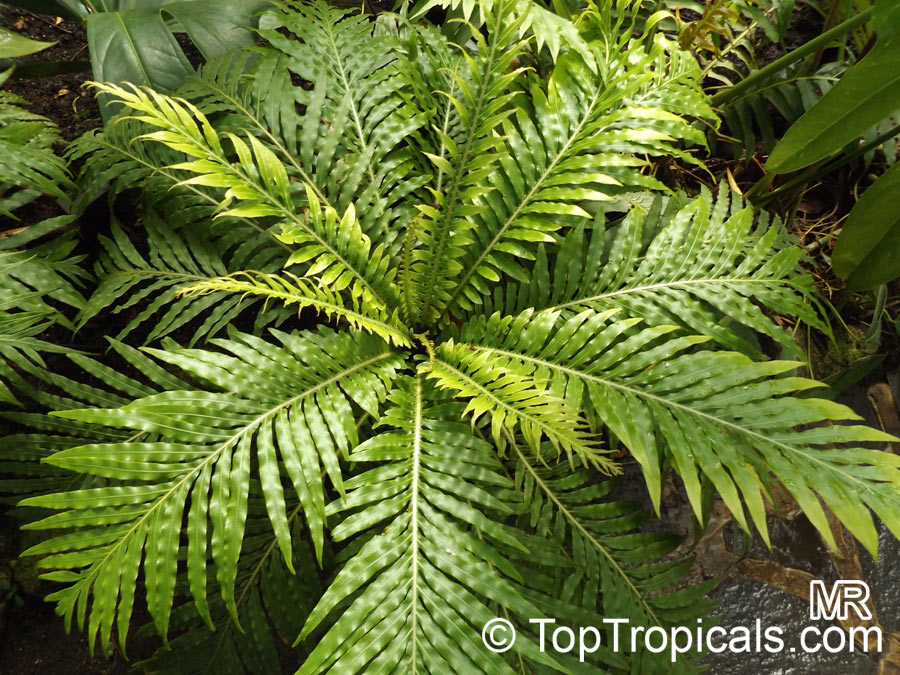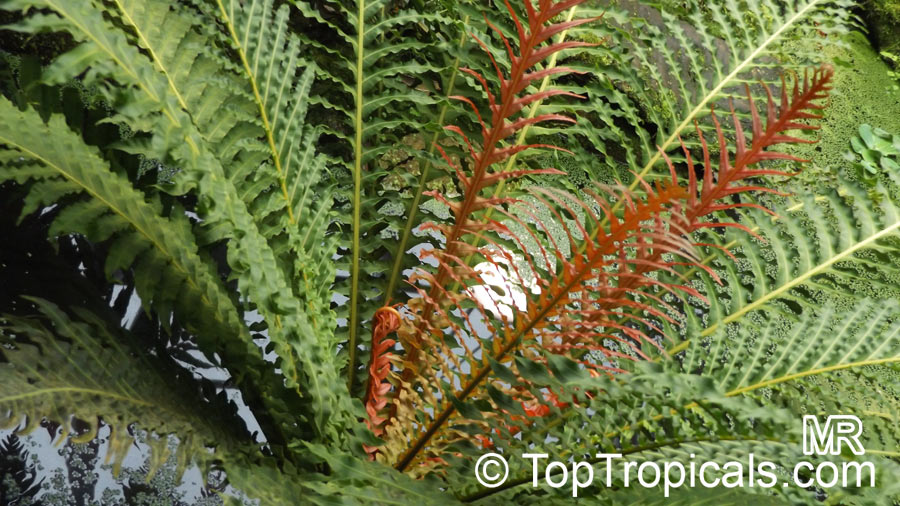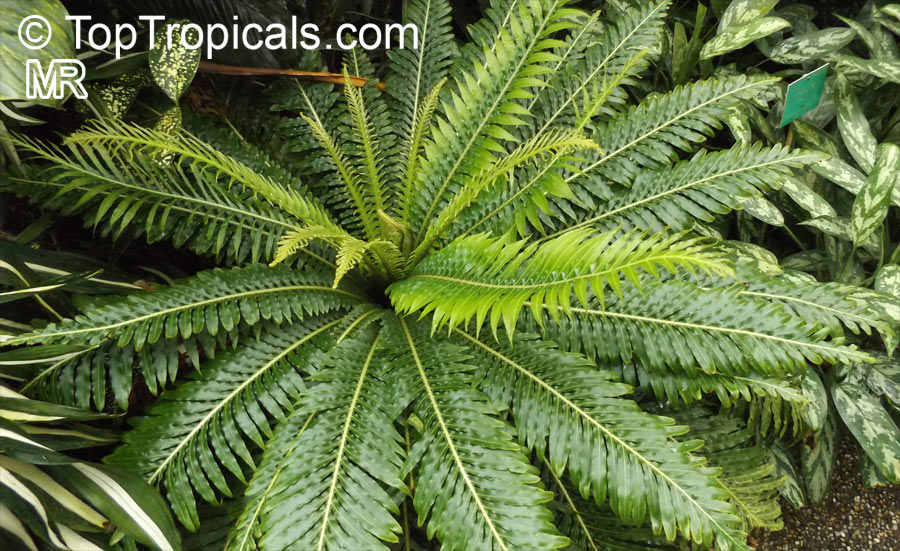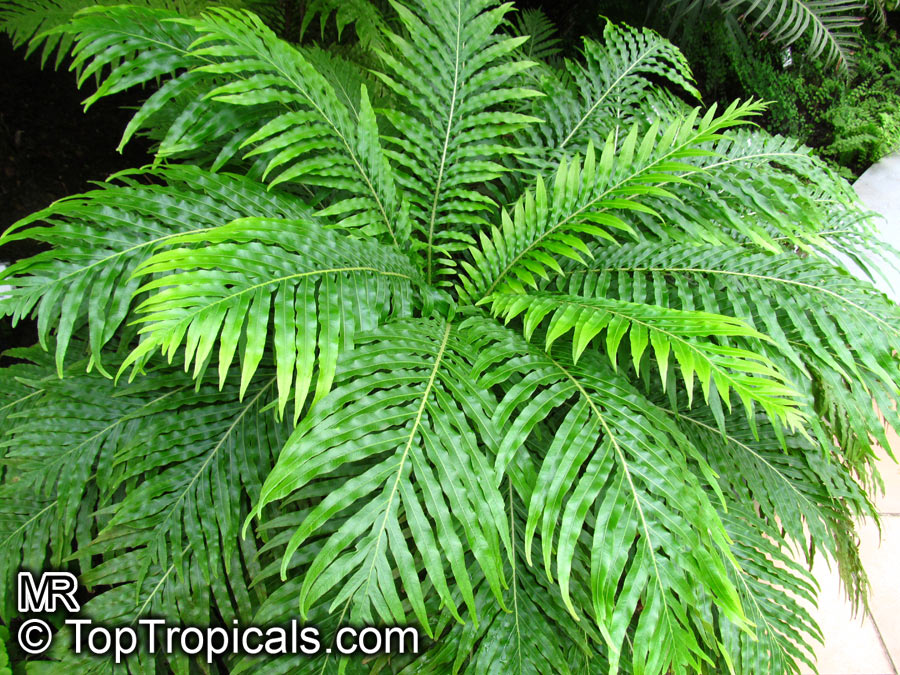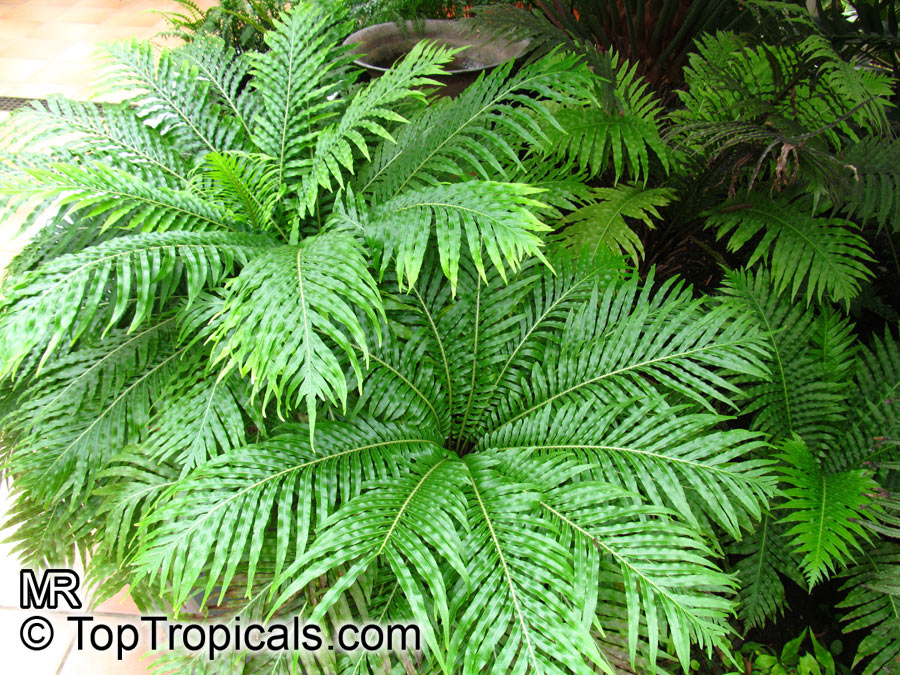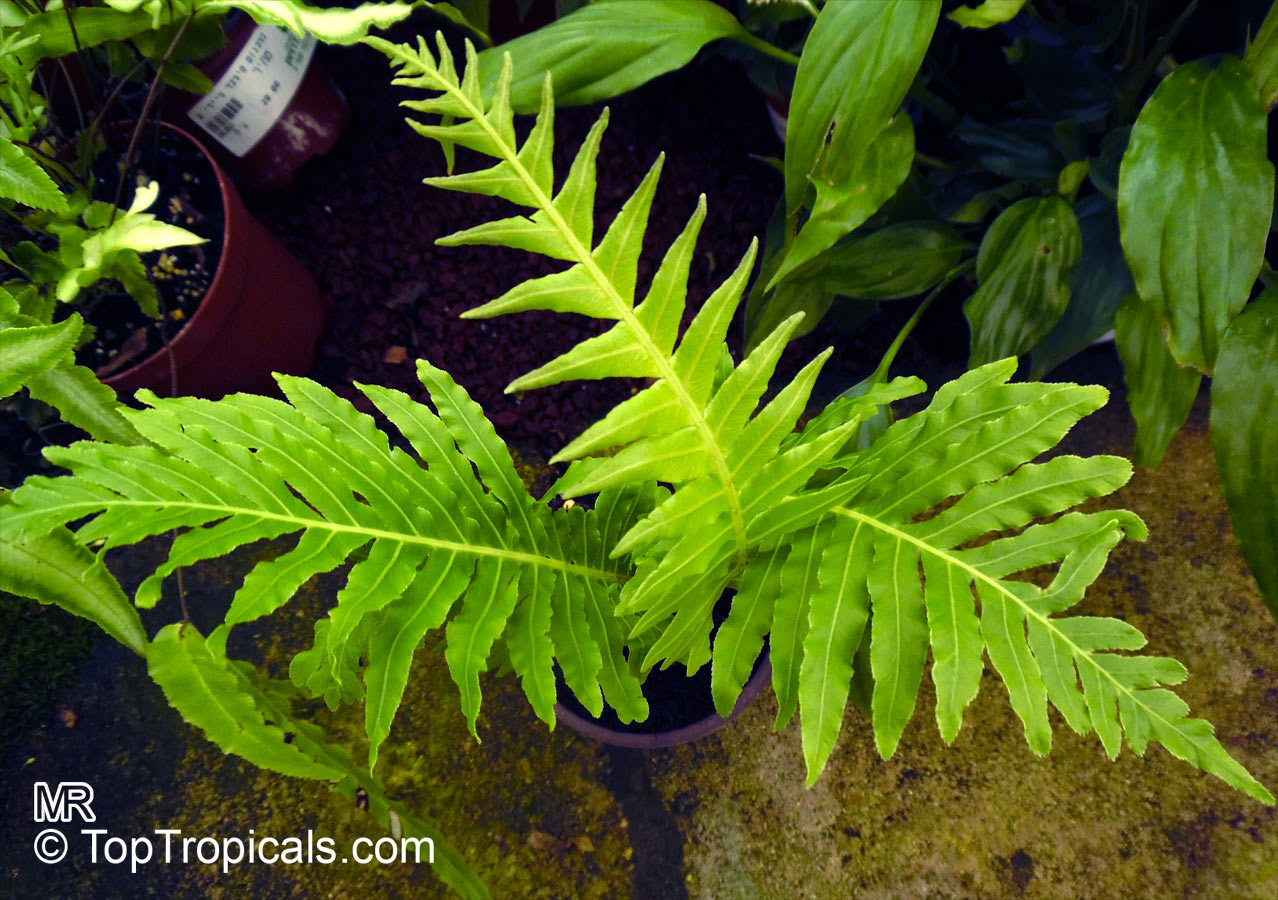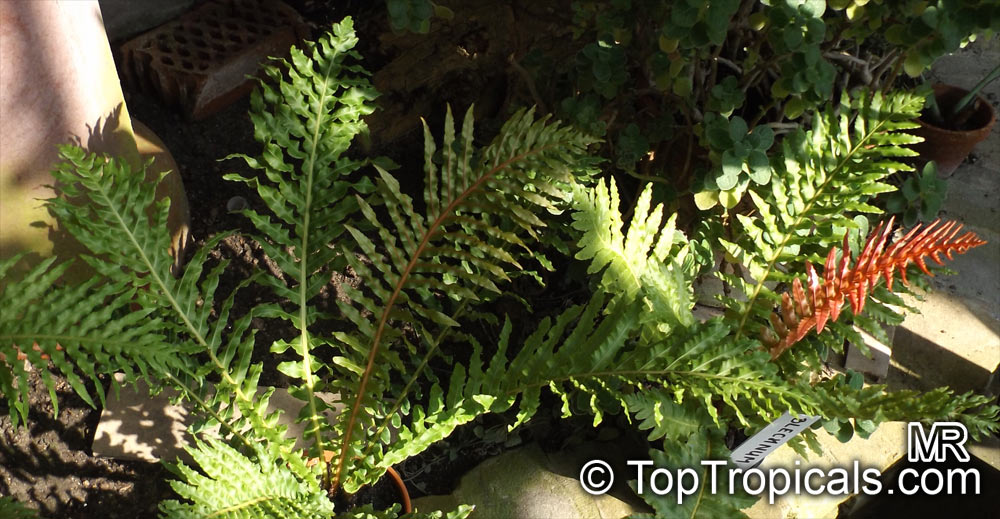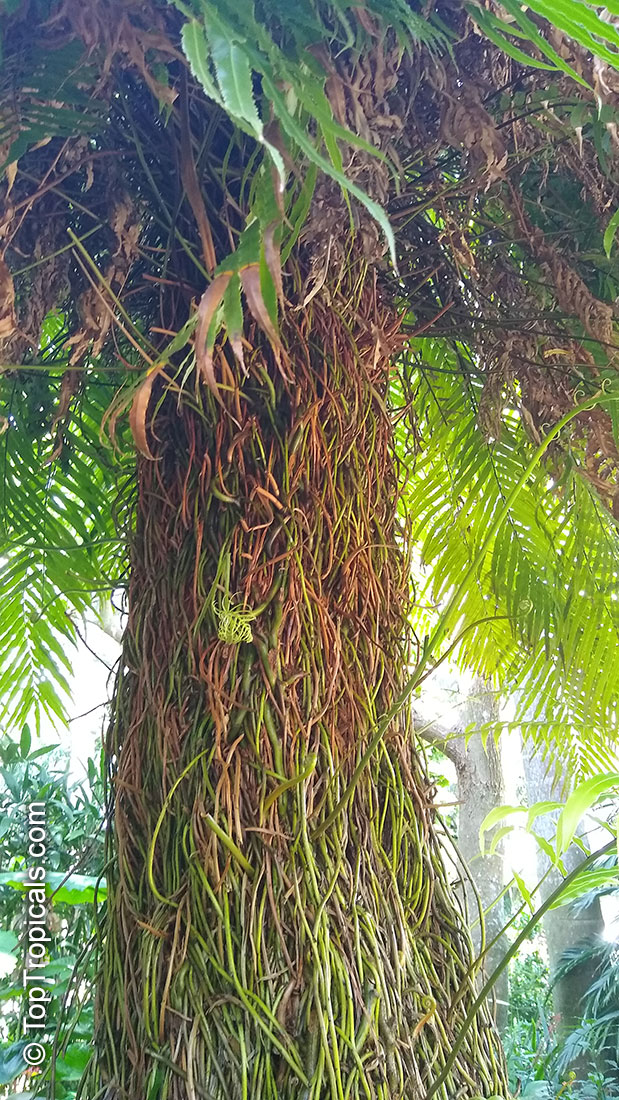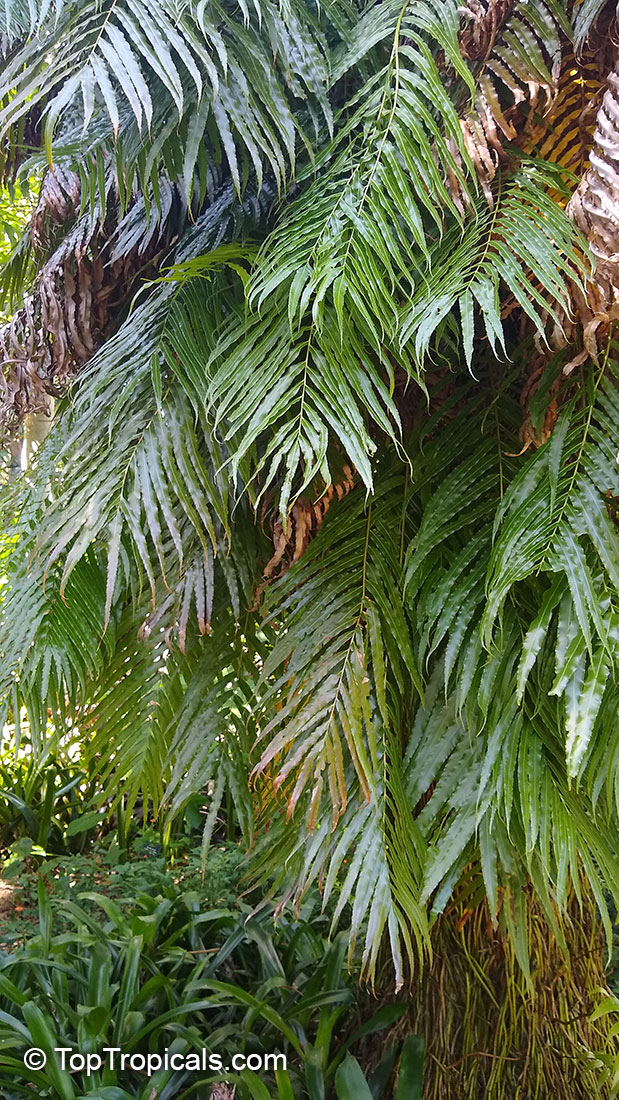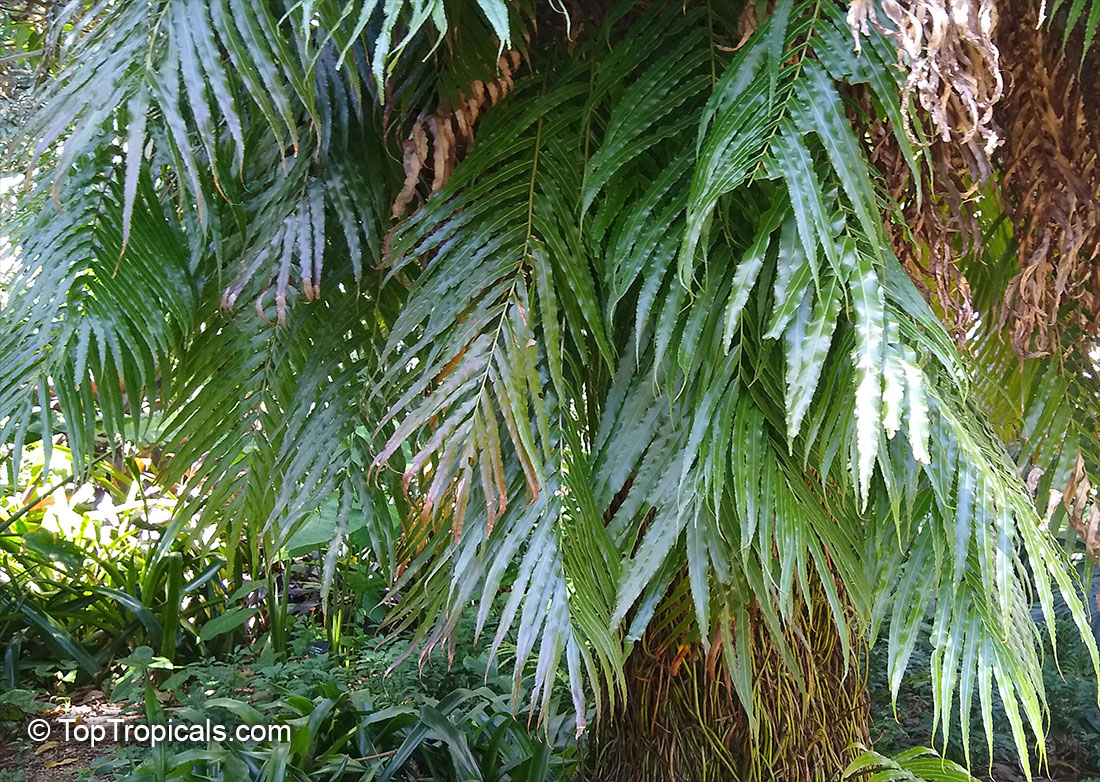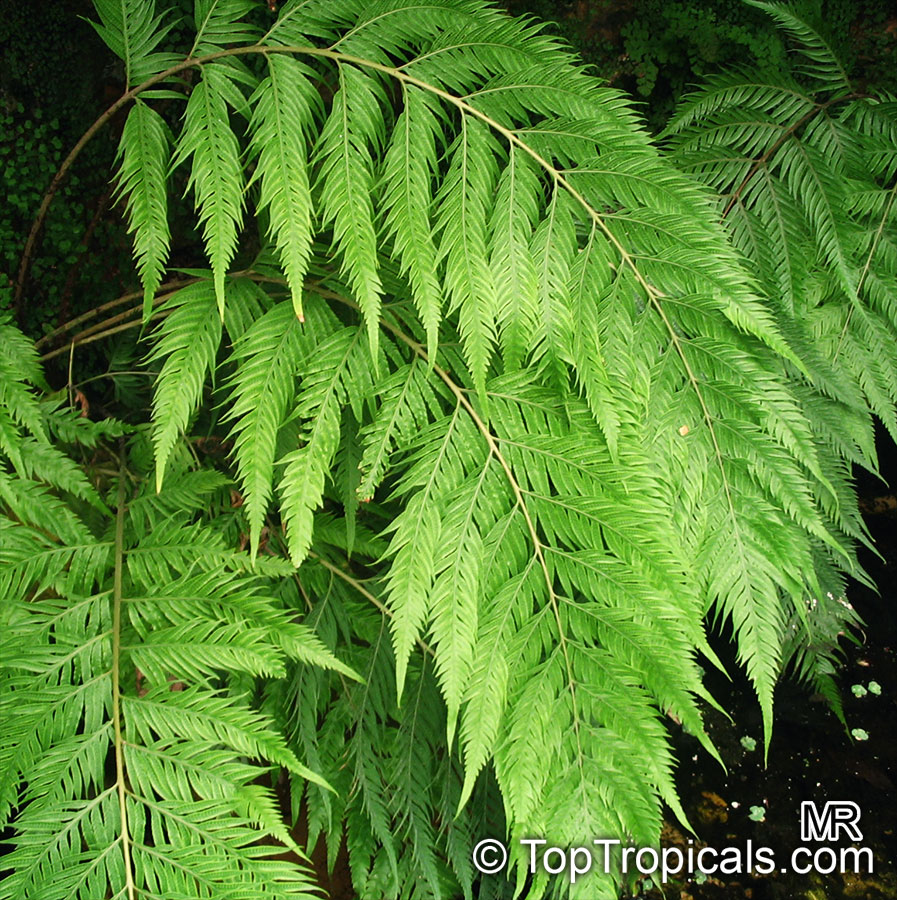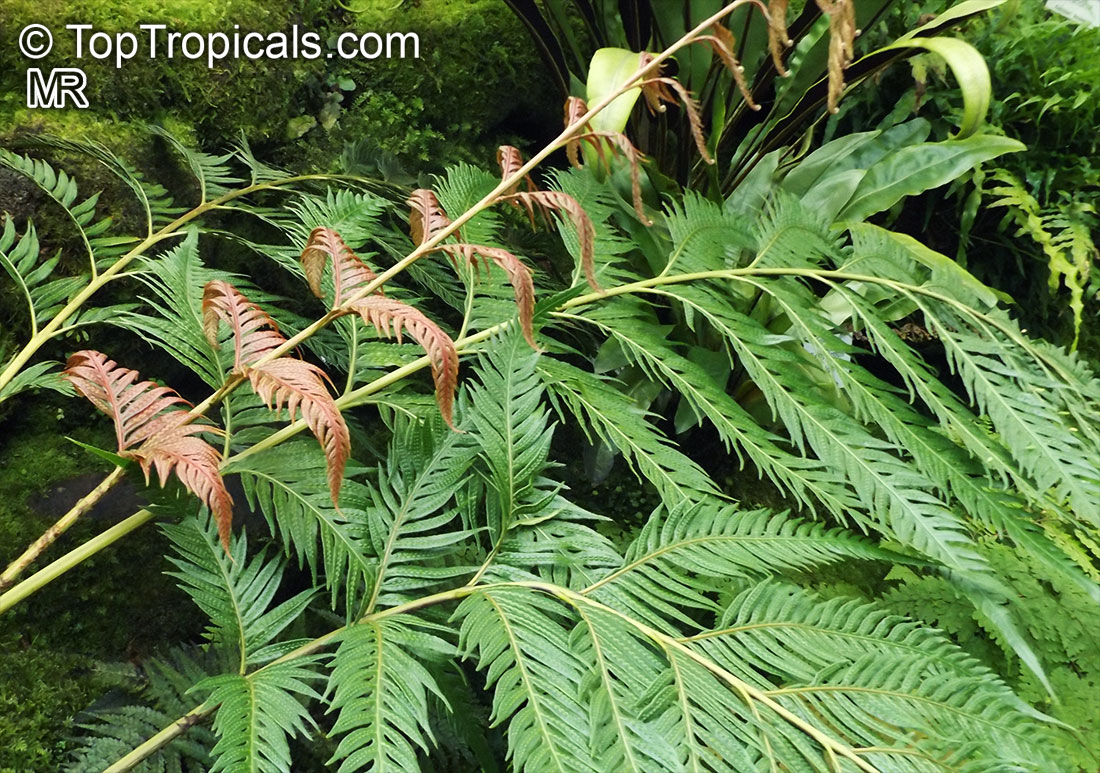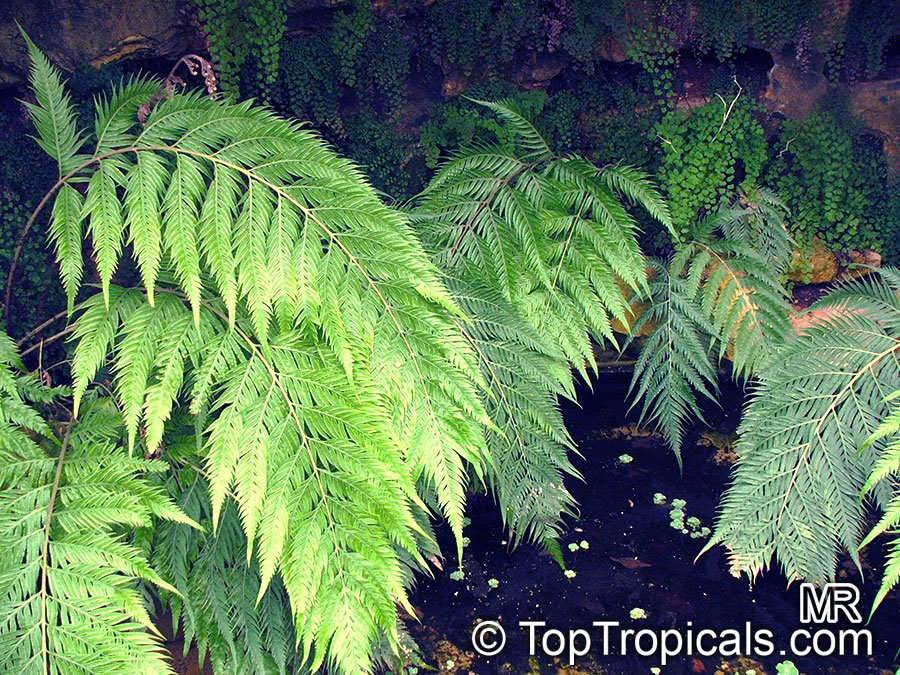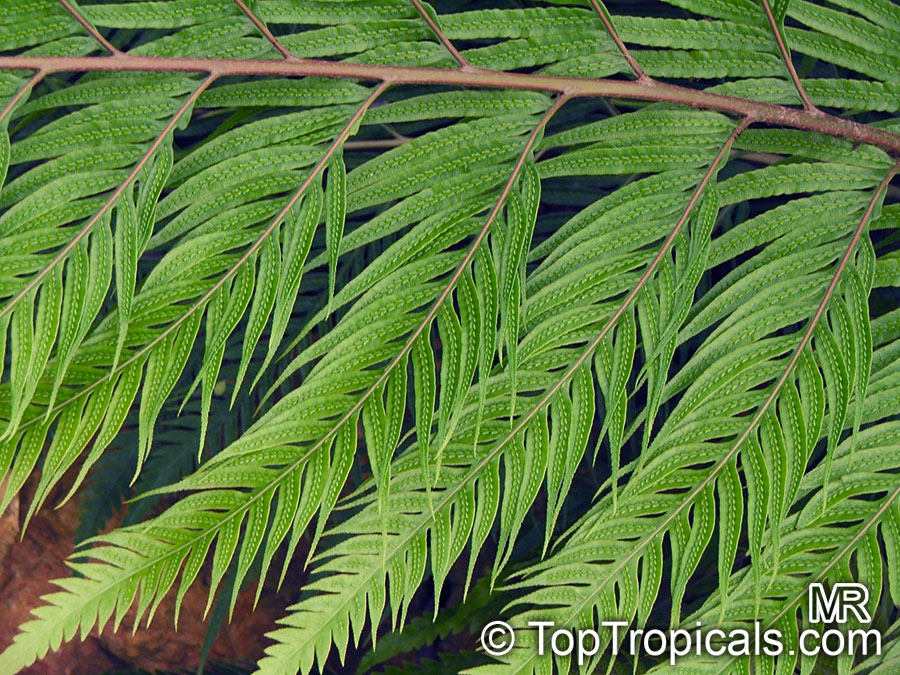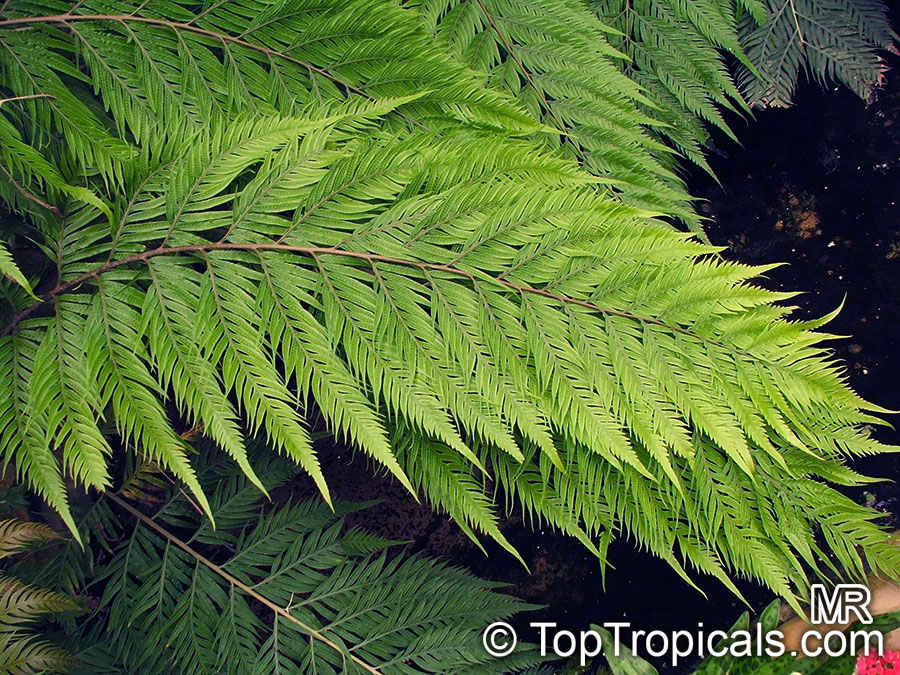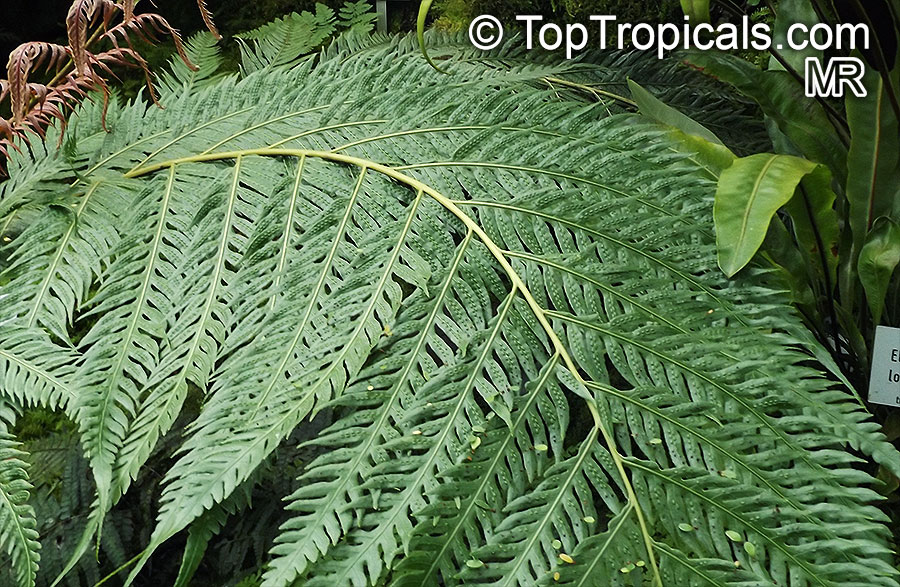Blechnaceae - Botanical Family
Top Tropicals Plant Encyclopedia
| Number of plants found: 8 |
Botanical name: Blechnum brasiliense
Common names: Red Dwarf Tree Fern, Red Brazilian Tree Fern
Family: Blechnaceae
Origin: South America





The Red Dwarf Tree Fern (Blechnum brasiliense) is a small perennial plant that originates from South America. It is a lovely ornamental fern with its attractive foliage, typically growing to be between 2 to 5 feet tall. It prefers to grow in partial sun or semi-shade and requires regular watering, however, do not over water it. It is also able to survive temperatures as cold as USDA Zone 9, making it somewhat hardy.
Being an understory fern, the Red Dwarf Tree Fern does best in warmth, humidity, and partial shade. When grown in a pot in colder regions, it is important to provide the fern with enough light that does not exceed the plant's threshold for exposure. The pot should also have a well-draining mix to avoid over-watering and root rot. It is recommended to move the plant indoors during the winter season.
Overall, the Red Dwarf Tree Fern is an excellent choice for those looking for a shade loving fern that is easy to care for and provides a great ornamental value to the garden. Its foliage and size make it a great choice for indoors, as well as a beautiful backdrop to larger outdoor shrubs and trees.
Botanical name: Blechnum discolor
Common name: Crown Fern
Family: Blechnaceae
Origin: New Zealand








Blechnum Discolor has bright green, upright fronds forming a crown shape. With age, this variety forms a short trunk and establishes an increasing colony around it. Long, dark brown fertile fronds stand upright in the centre of the crown.
This fern is best suited to dappled light - although will tolerate a sunny situation provided the soil is kept moist. It will cope with a wide range of conditions, including dry, frosts, and full sun to shade. Fairly hardy but would need some protection from the cold where temperatures dip below -3C for a period of time.
Botanical name: Blechnum gibbum
Common names: Dwarf Tree Fern, Silver Lady Fern
Family: Blechnaceae
Origin: South America




Native to the South Pacific and warm parts of South America, this plant is a popular choice for brightening up shaded outdoor areas. Blechnum gibbum (Dwarf Tree Fern) thrives in a semi-shady position and will reach a height of between 2 and 5 feet tall. Its ornamental foliage is a popular choice for interior landscaping and as a result is widely cultivated and sold.
This is an easy-care fern and will succeed in a wide variety of soils so long as it is kept in a moist, humid environment. Water regularly to keep the soil moist and mist the foliage regularly. It will also benefit from a regular application of liquid fertilizer to its soil.
Grown in USDA Zone 9-11, this fern can be grown in colder regions as long as it is kept in a pot and overwintered in an area that is cool and out of direct sunlight. During the winter months, it is best to water sparingly and mist regularly to ensure that the soil does not dry out. This will help Blechnum gibbum to survive the cooler temperatures and stay healthy.
To keep this fern looking its best, prune away any dead or yellowing leaves. This will help the plant to stay lush and will promote new growth.
Overall, Blechnum gibbum is a small but hardy fern and an ideal choice for an ornamental indoor or outdoor garden. With adequate care and attention, you can be sure that this fern will stay looking its best for many years to come.
Botanical name: Blechnum moorei
Common name: Brazilian Tree Fern
Family: Blechnaceae
Origin: South America






This is one of the better known and more common species of Blechnum in warmer climates. It forms a small trunk. On some forms, the new fronds emerge a beautiful pinkish-red, making the fern very attractive.
Does not like excessive watering, but must not dry out, a free draining potting mix and a high amount of sunlight. This fern is tropical and is hardy to USDA Zone 9.
Close related spacies Blechnum moorei - Brazilian Tree Fern is a compact grower and makes a great house plant.
Botanical names: Stenochlaena tenuifolia, Lomariopsis tenuifolia
Common name: African Climbing Fern
Family: Blechnaceae
Origin: Tropical Africa










Stenochlaena tenuifolia, commonly known as African climbing fern, is native to tropical Africa. The plant features feathery looking fronds with star-shaped leaflets. The stem of the plant is long and thin, allowing it to climb while its short-creeping rhizomes and powerful root systems create a dense groundcover. The fern often reaches heights of two feet and can even climb as high as twenty feet.
African climbing fern is extremely adaptable and is able to tolerate both full sun or deep to moderate shade. It does prefer humid climates and grows best in USDA zones 9-11. The fern has a high water requirement, meaning it requires regular water to thrive.
The plant has been traditionally foraged for edible fiddleheads and its numerous ethnomedical uses. The leaves are thought to have antibacterial, anti-inflammatory and anti-tumor healing properties. The fiddleheads are a popular delicacy in numerous African countries and can be boiled, steamed, fried or added to curries and soups. The mature fronds of the plant can also be eaten, though they are tough and fibrous.
African climbing fern prefers to grow in a pot in cold regions and can be easily propagated by division of the rhizomes. The plant not only adds visual interest to the garden with its beautiful, feathery foliage but will also reward with edible fruits which ripen over summer and autumn. The fruits are rich in essential oils, vitamins, trace elements and acids and have a slightly sweet and acidic flavor. Fruit size can vary from seed to seed but are usually around 5-10mm in diameter and can provide a plentiful bounty of up to 2,000 fruits from a single plant once it is established.
Botanical name: Woodwardia orientalis
Common name: Oriental Chain Fern
Family: Blechnaceae
Origin: Himalayas, Japan, China, Taiwan, Phillipines






Woodwardia orientalis (Oriental Chain Fern) is a small shrub that usually grows no taller than 2-5ft in height. Native to the Himalayas, Japan, China, Taiwan, and the Philippines, this perennial herbaceous plant is a popular ornamental foliage plant due to its attractive cascading fronds.
For gardeners living in USDA Zones 8-10, this fern is easy to cultivate from bulbs in gardens or containers. It requires partial to full shade to thrive and prefers moist soil. Regular watering is recommended to keep the soil moist but not soggy, as this can cause root rot. It's also important to consider growing in pots if you live in a cold region and to make sure the pots are well-drained during the winter months.
The Oriental Chain Fern is best grown as an accent plant in garden beds, near water features, or around entryways. This sturdy evergreen fern can be planted in groups or clusters, used as a short ground cover, or featured as a solitary specimen. Pruning can be done to shape the fern and to remove any dead growth that may have occurred.
Overall, Woodwardia orientalis (Oriental Chain Fern) is a simple and elegant addition to any garden. Its cascading fronds give the plant a beautiful, multidimensional look and its bulbils are easily detached for replanting and quick propagation. With the right care and conditions, this fern can offer your garden plenty of ornamental beauty that will surely bring you joy!
Use link to repeat this search:
https://toptropicals.com/cgi-bin/garden_catalog/cat.cgi?search_op=and&keyword_op=and&language=e&family=Blechnaceae&number=10
&no_change_lang=1&user=tt&sale=1&first=0
